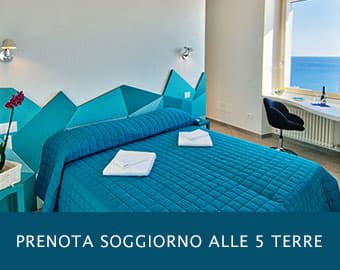Recommended
by CinqueTerre.com
 The ancient original nucleus of Monterosso is located on the hill of San Cristoforo, which separates the village into two; with the increase in population, in the 12th and 13th centuries, the people went down to the valley and settled along the banks of the Branco stream (now covered). This part of the village, called Monterosso Vecchia, has remained practically intact and has the same characteristics as the other Cinque Terre towns. It is dominated by the imposing mass of the remains of the 'castrum' obertengo, with the beautiful parish church of San Giovanni Battista at the intersection of the main streets. Instead, a modern residential neighborhood winds along the sea promenade in the Fegina inlet, which gives its name to the area.
The ancient original nucleus of Monterosso is located on the hill of San Cristoforo, which separates the village into two; with the increase in population, in the 12th and 13th centuries, the people went down to the valley and settled along the banks of the Branco stream (now covered). This part of the village, called Monterosso Vecchia, has remained practically intact and has the same characteristics as the other Cinque Terre towns. It is dominated by the imposing mass of the remains of the 'castrum' obertengo, with the beautiful parish church of San Giovanni Battista at the intersection of the main streets. Instead, a modern residential neighborhood winds along the sea promenade in the Fegina inlet, which gives its name to the area.
 The beach of Monterosso is the largest of the Cinque Terre and this element, together with the urban development of the new district, has determined the tourist vocation of the country; In fact, Monterosso has the greatest hospitality in the Cinque Terre. Monterosso, with its promenade and beach, lends itself better than other countries to host a bit of social life and nightlife; in this respect it is certainly an excellent complement to the tranquility of Riomaggiore and Corniglia. The carruggi of the old town are very beautiful and suggestive; larger spaces and a few cars in Fegina and on the waterfront.
The beach of Monterosso is the largest of the Cinque Terre and this element, together with the urban development of the new district, has determined the tourist vocation of the country; In fact, Monterosso has the greatest hospitality in the Cinque Terre. Monterosso, with its promenade and beach, lends itself better than other countries to host a bit of social life and nightlife; in this respect it is certainly an excellent complement to the tranquility of Riomaggiore and Corniglia. The carruggi of the old town are very beautiful and suggestive; larger spaces and a few cars in Fegina and on the waterfront.
Monterosso: what to see
 The Capuchin convent with the church of San Francesco stand on the hill of San Cristoforo which divides the old and new part of the village. The Convent represents a strong attraction for the high historical and artistic value of the art treasures that it preserves, including the "Crucifixion" by the famous Flemish painter Antoon van Dyck, "San Girolamo penitente" by Luca Cambiaso, the refectory sometimes with "La Veronica" by Bernardo Strozzi. Beautiful panoramic paths climb the hill, meeting the statue of St. Francis, vegetable gardens and small doors that open onto the blue of the sea. A little further down is Torre Aurora which was part of the defensive walls built in the XVI century by the Republic of Genoa to face pirate raids.
The Capuchin convent with the church of San Francesco stand on the hill of San Cristoforo which divides the old and new part of the village. The Convent represents a strong attraction for the high historical and artistic value of the art treasures that it preserves, including the "Crucifixion" by the famous Flemish painter Antoon van Dyck, "San Girolamo penitente" by Luca Cambiaso, the refectory sometimes with "La Veronica" by Bernardo Strozzi. Beautiful panoramic paths climb the hill, meeting the statue of St. Francis, vegetable gardens and small doors that open onto the blue of the sea. A little further down is Torre Aurora which was part of the defensive walls built in the XVI century by the Republic of Genoa to face pirate raids.
 In the old part of the town, along the characteristic alleys, you will encounter the Church of San Giovanni Battista, set among other historic buildings. Built between the 13th and 14th centuries, it represents an example of pure Genoese Gothic style. The façade has white and dark serpentine bicrome bands, a beautiful rose window in richly carved white marble, the lunette of the portal with a fresco from the 18th century. The interior preserves a painting of the "Madonna del Rosario" by Luca Cambiaso and an inscription in medieval characters engraved on a column. The bell tower was originally a medieval watchtower of the fortifications built by the Republic of Genoa in the 13th century. Behind is the baroque Oratory of Santa Maria di Porto Salvo.
In the old part of the town, along the characteristic alleys, you will encounter the Church of San Giovanni Battista, set among other historic buildings. Built between the 13th and 14th centuries, it represents an example of pure Genoese Gothic style. The façade has white and dark serpentine bicrome bands, a beautiful rose window in richly carved white marble, the lunette of the portal with a fresco from the 18th century. The interior preserves a painting of the "Madonna del Rosario" by Luca Cambiaso and an inscription in medieval characters engraved on a column. The bell tower was originally a medieval watchtower of the fortifications built by the Republic of Genoa in the 13th century. Behind is the baroque Oratory of Santa Maria di Porto Salvo.
 Passing in the new part of Monterosso, the Fegina, the main attraction is represented by the statue of the Giant that dominates the free beach, of large dimensions and set in a rocky spur. It is a sculpture in reinforced concrete and iron made in 1910 by Arrigo Minerbi of Ferrara and engineer Levacher, at the behest of Giovanni and Juanita Pastine, monterossini returned from Argentina after having made a fortune, to adorn their Villa Pastine, in later destroyed by bombing during World War II, a fate that, in part, also fell to the statue of the Giant. Originally, in fact, the Giant, held on his shoulders, a concrete shell with part of the garden of the villa inside. 14 meters high and 1700 quintals high, the statue depicts Neptune, god of the waters and seas, and was originally also equipped with a trident.
Passing in the new part of Monterosso, the Fegina, the main attraction is represented by the statue of the Giant that dominates the free beach, of large dimensions and set in a rocky spur. It is a sculpture in reinforced concrete and iron made in 1910 by Arrigo Minerbi of Ferrara and engineer Levacher, at the behest of Giovanni and Juanita Pastine, monterossini returned from Argentina after having made a fortune, to adorn their Villa Pastine, in later destroyed by bombing during World War II, a fate that, in part, also fell to the statue of the Giant. Originally, in fact, the Giant, held on his shoulders, a concrete shell with part of the garden of the villa inside. 14 meters high and 1700 quintals high, the statue depicts Neptune, god of the waters and seas, and was originally also equipped with a trident.
Useful Information
How to reach Monterosso:
- By train: it is advisable to use the train via the special Cinque Terre Express services that Trenitalia provides about every 10 minutes in spring-summer. Monterosso stop.
- By car: from the center of La Spezia, after the A.Picco stadium take the SP 370 and after Manarola continue on the SP 51. In San Bernardino, instead of turning left proceed on the main road SP 51, after 9 km you arrive at crossroads with Vernazza and continue on the SP 51, to the right, uphill, until you reach the SP 38 coming from Pignone-Val di Vara which represents another route to reach Monterosso.
- Sea connections: ferries available every spring and summer departing from La Spezia, Lerici and Porto Venere. Monterosso is capoline adelle internal lines. For more information and timetables: www.navigazionegolfodeipoeti.it
Info Point Reception and Tourist Information: located at the railway station, Tel. 0187/817059, mail: parcoragazze@hotmail.com





